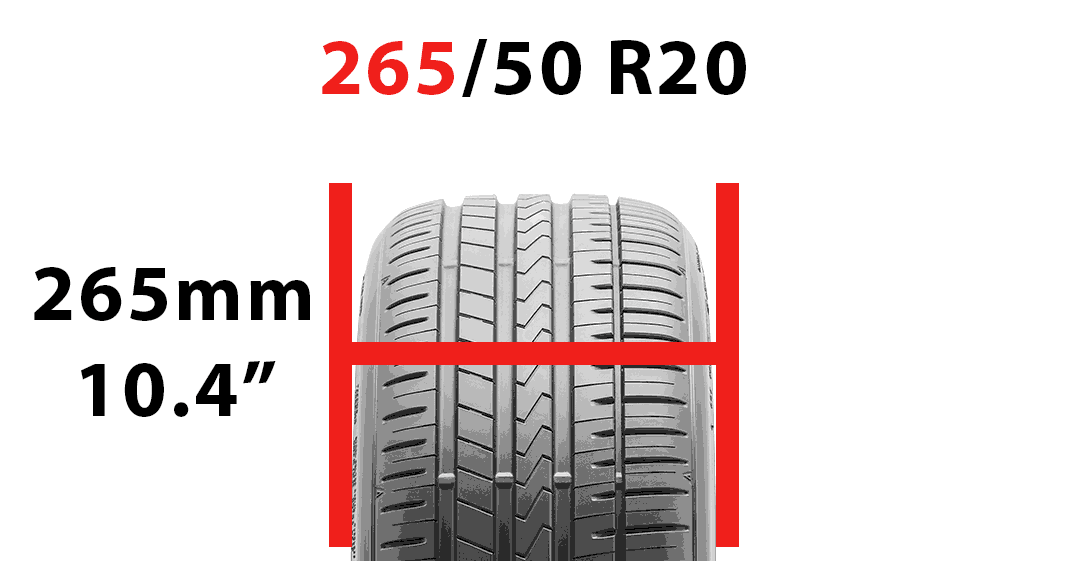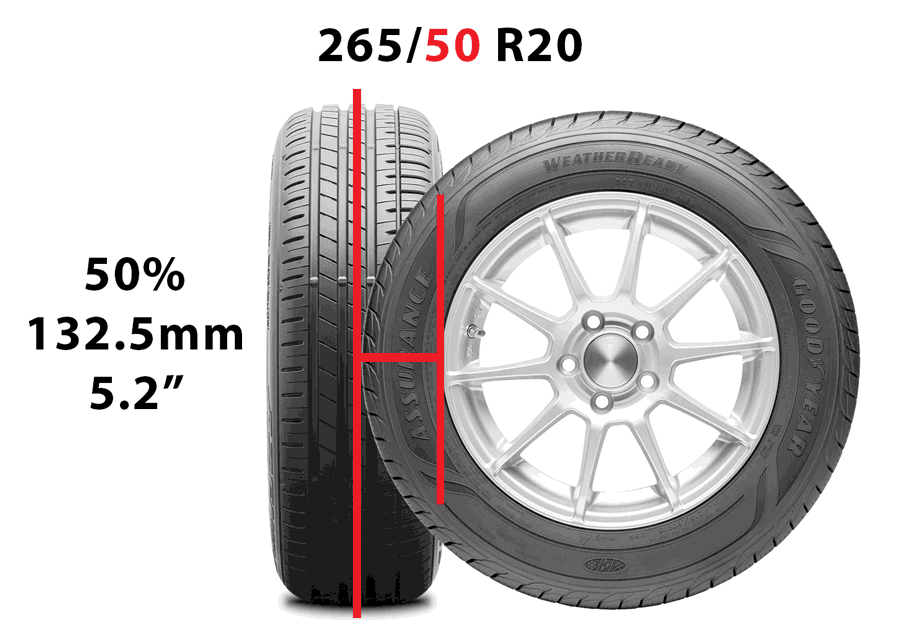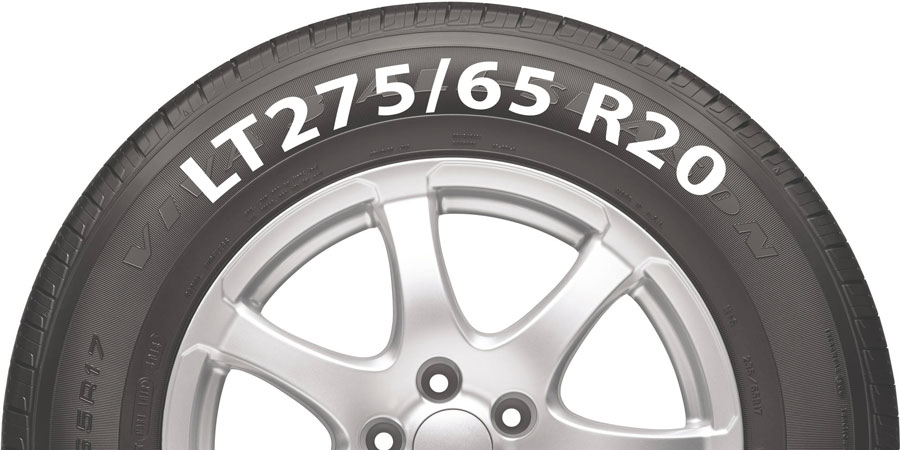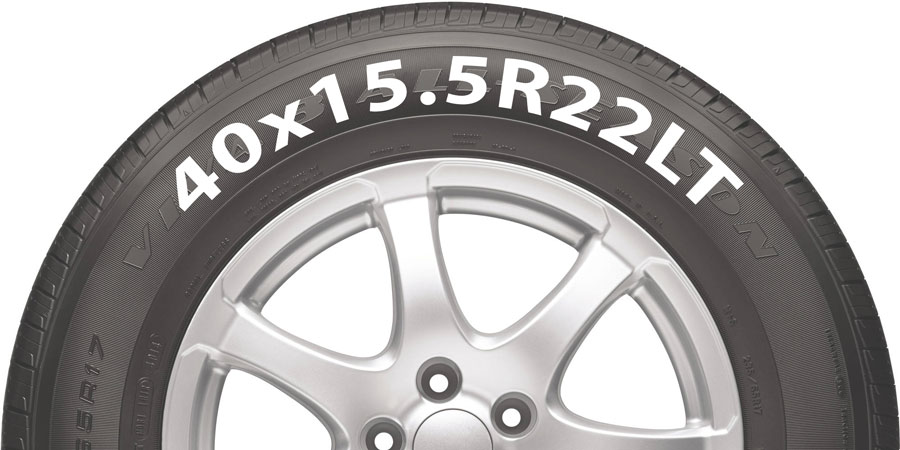How to read a tire sidewall
Updated on 17.07.2023
When it comes to buying tires, you might have faced confusion while looking at the tire sizing chart. The series of letters and numbers might seem perplexing at first. However, by using this concise guide, you'll gain the ability to accurately understand and interpret these tire measurements. The numbers on a tire aren't as daunting as they initially appear. After familiarizing yourself with this brief tutorial, you'll be adept at decoding and understanding what exactly those tire dimensions signify.

There are two types of size measurements: metric and flotation.
Metric covers a majority of tires people buy and it's more difficult to understand, so we're going to go ahead and start there. There are seven sections for metric sizing. First letters designate
- P – passenger
- LT – light truck
- ST – special trailer
- T – temporary rated tires.
If a tire doesn't specify it, then it's most likely a passenger tire. Just be sure to double-check the tires load rating.
"P-metric" is a designation for a type of tire sizing system used primarily in the United States. It originated from the P-metric system, a tire-sizing system established in the late 1970s by the Tire and Rim Association.
The "P" in P-metric stands for "passenger," as in passenger vehicles. This system is used to specify tire sizes for passenger vehicles like cars, minivans, sport utility vehicles (SUVs), and light-duty pickup trucks.
Up next is the section width or the width from the sidewall to sidewall in millimeters.

Following that is the aspect ratio, which we'll explain when we get down to the hard numbers.
Next, you'll see an R which stands for radial.
The next number is a wheel size in inches.
The last thing you'll see is the load rating and speed rating.
So let's look at how these numbers translate to a real tire.
This tire doesn't list P or LT, so it's a passenger tire. The 265 means the width is 265 mm or 10.4 inches wide. Then we have the aspect ratio, this number represents the size of the sidewall compared to the section width. The 50, in this case, means that the sidewall is 50% of the width or 5.2 inches. 50 sidewall to sidewall in millimeters is 132 mm

The R just means radial construction as opposed to bias ply. And the final number, 20, that's the wheel size. Now that we've got the width, sidewall size, and wheel size, we can take all that together and get the height of the tire.
- Tire Width: 10.4"
- Tire's Sidewall: 5.2"
- Wheel diameter: 20"
We'll take the sidewall size, add the wheel size, and then add the sidewall size one more time.
Now that (10.4"+5.2"+5.2"+20") gives us a height of 30.4 inches.
Let's take a look at another tire, the LT 275/65R20.

The LT stands for a light truck. The width is 275 millimeters or 10.8 inches. The sidewalls are 65% of 10.8 inches which equals seven inches and it's radial construction. It also fits a 20-inch wheel. The tire's overall height is 34.1 inches.
So one last example of metric sizing, LT 315/75R16. This is a light truck tire that is 315 millimeters wide or 12.4 inches. Sidewalls are 9.3 inches and it fits a 16-inch wheel for a total height of 34.6 inches. If you don't want to do all the math yourself, we've got a handy calculator.
Understanding factors like sidewall height, tire width, and diameter differences are crucial when purchasing new tires, as they can significantly impact your vehicle's comfort, handling, and even aesthetics. Sidewall height, for instance, directly affects your ride's smoothness. Tire width can influence grip, and the diameter difference can affect speedometer accuracy and fuel economy.
To accurately evaluate and compare these measurements, a tire calculator can be highly beneficial. It allows you to examine various tire sizes and comprehend how these dimensions could alter your driving experience. For a straightforward and user-friendly tire calculator, you can visit this link: Tire Size Calculator. Utilizing this tool will aid in simplifying your decision-making process when selecting tires.
Flotation sizing is even easier than the metric.
Here's just how easy it is. A 40 x 15.5 R22LT is 40 inches tall, 15.5 inches wide, and fits a 22-inch wheel. Tires are marked with numbers such as 40 x 15.5 R22LT to help you choose the right one for your vehicle. Breaking it down:
- First two numbers, '40' denotes the height of the tire from the wheel rim to the top of the tire. It means the diameter of the tire is 40 inches.
- '15.5' refers to the width of the tire, i.e., how broad the tire is.
- 'R' in this context is short for Radial, which means the layers of fabric run radially across the tire.
- '22' signifies the wheel diameter that the tire is intended to fit, i.e., this tire would fit a 22-inch wheel.
- Lastly, ‘LT’ stands for 'light truck', indicating that this tire is designed for light trucks.

What is diagonal bias construction?
Diagonal bias construction, also known as bias-ply construction, is a method of tire construction that was common before the invention of radial tires. In a bias-ply tire, the fabric plies or layers that give the tire its structure are arranged in a crisscross pattern, generally at angles around 30 to 40 degrees to the direction of travel.
The name "bias-ply" comes from this diagonal, or "bias" arrangement of the plies. This construction method makes the sidewalls and tread act as a single unit, so a change in sidewall shape from a bump, for example, can cause a similar change in the tread. This makes the tire less likely to deform and more resistant to damage from rough road conditions.
Bias-ply tires have largely been replaced by radial tires in passenger vehicles because radial tires tend to offer better fuel efficiency, durability, and road-holding characteristics. However, bias-ply tires are still used in certain applications, such as in heavy-duty trucks, trailers, farm equipment, and certain off-road vehicles, because of their resistance to damage and the fact they can carry heavy loads at low speeds.
What are belted bias tires?
Belted bias tires, also known as belted-bias ply or bias-belted tires, are a type of tire construction that combines features of bias ply tires and radial tires.
Similar to bias ply tires, belted bias tires have plies that run diagonally from one bead to the other, at about a 30-40 degree angle to the direction of travel. However, like radial tires, belted bias tires also have one or two belts (usually made of fiberglass or steel) running around the tire under the tread. This combination of features aims to offer some of the stability and tread wear benefits of radial tires while retaining the toughness and load capacity of bias ply tires.
Belted bias tires were quite popular in the 1960s and 1970s as a transition technology between bias ply and radial tires, but they have been largely replaced by radial tires in most passenger vehicles today because radial tires generally offer superior handling, fuel efficiency, and tread life. However, you may still see belted bias tires used in some applications such as classic cars or certain types of off-road vehicles.
What does ZR mean on tires?
For some reason, tire makers decided to mark high-speed-rated tires with an additional Z letter. We think this is made just for a cooler look. If you're driving Type-R, GT-R, or any other GT-Super-High-Speed-Vehicle-R, you're probably going to love that "sporty" touch. But the reality is trivial: ZR stands for tires, that have a speed rating of more than 149mph, so that includes V, W, and Y-rated tires.
What does M+S stand for on tires?
M+S, or M/S, stands for "Mud and Snow." This marking is found on the sidewalls of tires that are designed to provide improved performance under muddy and snowy conditions compared to standard all-season tires.
Tires marked with M+S have been designed with a tread pattern that's better at clearing mud and snow out from the tire as it rotates, thereby providing better traction. It's important to note, however, that M+S tires are not necessarily the same as winter tires.
While M+S tires may provide better traction in light snow, dedicated winter or snow tires are made with a special rubber compound that stays softer and more flexible in very cold weather for better grip. They also have more advanced tread designs for better traction on icy or snowy roads. They're often marked with a symbol that shows a mountain with a snowflake inside it, which is the symbol for a true winter tire.
What are the DOT numbers on tires?
The DOT code, also referred to as the DOT serial number, is an alphanumeric code printed on a tire. This code confirms that the tire meets all safety standards as defined by the Department of Transportation (DOT) and offers a wealth of information about the tire.
Typically, this DOT code is a string of 10-12 characters comprising both numbers and letters. It discloses various details such as the manufacturer, tire size, type, and specifics about when and where the tire was manufactured.
The final four digits of the DOT code are particularly crucial for consumers as these numbers indicate the week and year the tire was manufactured. For example, if these last four numbers are 2319, it signifies that the tire was produced during the 23rd week of 2019. This information is particularly useful for determining a tire's age, a significant factor since tires can degrade over time even when not in use.
Remember that for safety, most tire manufacturers recommend that you replace your tires after they're about six to ten years old, regardless of their wear.
What is the tire speed rating?
The Speed Rating - the speed symbol on the sidewall indicates the maximum design speed of the tire.
As with the Load Index, there is a table of speed index values with values ranging from A (minimum value) to Z (maximum value). However, with one exception: the letter H falls out of the sequence and is between U and V, corresponding to speeds up to 210 km/h.
Failure to match the speed index of the tire with the maximum speed of the car (in case the maximum speed of the car is higher than the speed index of the chosen tire) may result in a rapid loss of the tire's performance characteristics, up to bursting of the tire.
Tire speed rating chart
| Speed rating | Speed in km/h | Speed in mph |
| A1 | 5 | 3 |
| A2 | 10 | 6 |
| A3 | 15 | 9 |
| A4 | 20 | 12 |
| A5 | 25 | 16 |
| A6 | 30 | 19 |
| A8 | 40 | 25 |
| B | 50 | 31 |
| C | 60 | 37 |
| D | 65 | 40 |
| E | 70 | 43 |
| F | 80 | 50 |
| G | 90 | 56 |
| J | 100 | 62 |
| K | 110 | 68 |
| L | 120 | 75 |
| M | 130 | 81 |
| N | 140 | 87 |
| P | 150 | 94 |
| Q | 160 | 100 |
| R | 170 | 106 |
| S | 180 | 112 |
| T | 190 | 118 |
| U | 200 | 124 |
| H | 210 | 130 |
| V | 240 | 149 |
| W | 270 | 168 |
| Y | 300 | 186 |
What is tire load index
Tire Load Index is a number that corresponds to the load a tire can carry at its maximum internal air pressure.
Improper matching of the load index to the weight of a loaded vehicle (if the vehicle weight exceeds the value of the tire speed index) may result in rapid loss of tire performance and may even result in the tire exploding.
Tire load index chart
| Load Index | Load (lbs) |
| 0 | 99 |
| 1 | 102 |
| 2 | 105 |
| 3 | 107 |
| 4 | 110 |
| 5 | 114 |
| 6 | 117 |
| 7 | 120 |
| 8 | 123 |
| 9 | 128 |
| 10 | 132 |
| 11 | 136 |
| 12 | 139 |
| 13 | 143 |
| 14 | 148 |
| 15 | 152 |
| 16 | 157 |
| 17 | 161 |
| 18 | 165 |
| 19 | 171 |
| 20 | 176 |
| 21 | 182 |
| 22 | 187 |
| 23 | 193 |
| 24 | 198 |
| 25 | 204 |
| 26 | 209 |
| 27 | 215 |
| 28 | 220 |
| 29 | 227 |
| 30 | 234 |
| 31 | 240 |
| 32 | 247 |
| 33 | 254 |
| 34 | 260 |
| 35 | 267 |
| 36 | 276 |
| 37 | 282 |
| 38 | 291 |
| 39 | 300 |
| 40 | 309 |
| 41 | 320 |
| 42 | 331 |
| 43 | 342 |
| 44 | 353 |
| 45 | 364 |
| 46 | 375 |
| 47 | 386 |
| 48 | 397 |
| 49 | 408 |
| 50 | 419 |
| 51 | 430 |
| 52 | 441 |
| 53 | 454 |
| 54 | 467 |
| 55 | 481 |
| 56 | 494 |
| 57 | 507 |
| 58 | 520 |
| 59 | 536 |
| 60 | 551 |
| 61 | 567 |
| 62 | 584 |
| 63 | 600 |
| 64 | 617 |
| 65 | 639 |
| 66 | 639 |
| 67 | 677 |
| 68 | 694 |
| 69 | 716 |
| 70 | 739 |
| 71 | 761 |
| 72 | 783 |
| 73 | 805 |
| 74 | 827 |
| 75 | 852 |
| 76 | 882 |
| 77 | 908 |
| 78 | 937 |
| 79 | 963 |
| 80 | 992 |
| 81 | 1019 |
| 82 | 1047 |
| 83 | 1074 |
| 84 | 1102 |
| 85 | 1135 |
| 86 | 1168 |
| 87 | 1201 |
| 88 | 1235 |
| 89 | 1279 |
| 90 | 1323 |
| 91 | 1356 |
| 92 | 1389 |
| 93 | 1433 |
| 94 | 1477 |
| 95 | 1521 |
| 96 | 1565 |
| 97 | 1609 |
| 98 | 1653 |
| 99 | 1709 |
| 100 | 1764 |
| 101 | 1819 |
| 102 | 1874 |
| 103 | 1929 |
| 104 | 1984 |
| 105 | 2039 |
| 106 | 2094 |
| 107 | 2149 |
| 108 | 2205 |
| 109 | 2271 |
| 110 | 2337 |
| 111 | 2403 |
| 112 | 2469 |
| 113 | 2535 |
| 114 | 2601 |
| 115 | 2679 |
| 116 | 2756 |
| 117 | 2833 |
| 118 | 2910 |
| 119 | 2998 |
| 120 | 3086 |
| 121 | 3197 |
| 122 | 3307 |
| 123 | 3417 |
| 124 | 3527 |
| 125 | 3638 |
| 126 | 3748 |
| 127 | 3858 |
| 128 | 3968 |
| 129 | 4079 |
| 130 | 4189 |
| 131 | 4289 |
| 132 | 4409 |
| 133 | 4541 |
| 134 | 4674 |
| 135 | 4806 |
| 136 | 4938 |
| 137 | 5071 |
| 138 | 5203 |
| 139 | 5357 |
| 140 | 5512 |
| 141 | 5677 |
| 142 | 5842 |
| 143 | 6008 |
| 144 | 6173 |
| 145 | 6393 |
| 146 | 6614 |
| 147 | 6779 |
| 148 | 6844 |
| 149 | 7165 |
| 150 | 7385 |
If you're interested in learning more about tire tread depth and its importance for vehicle safety and performance, I recommend checking out this comprehensive guide. It covers everything you need to know, from what tread depth is, why it's important, to how you can check it yourself. Simply follow this link to the article: Everything About a Tire Tread Depth. This resource offers in-depth information that can help you make informed decisions about your vehicle's tires.